
Port
Mumbai
The demand for imported lentils showed an improvement this week. As a result, the price of imported lentils kept rising while domestic lentil prices declined. Mumbai lentils registered an increase of Rs. 50/75 per quintal this week due to an increase in buying. In Mundra, lentils traded at Rs. 7,300/7,350, in Hazira at Rs. 7,400/7,450 and container lentils traded at Rs. 7,450/7,550 per quintal last week.
Delhi
Due to weak demand, Delhi lentils recorded a fall of Rs. 50/100 per quintal and domestic large size lentils traded at Rs. 7,750, in Bundi at Rs. 7,650, in the Uttar Pradesh line at Rs. 7,750 and imported lentils traded at Rs. 7,550 per quintal.
Madhya Pradesh
Due to continued selling pressure and weak buying, Madhya Pradesh lentils remained bearish at Rs. 50/150 per quintal and were sold at Rs. 7,850, in Indore prices were Rs. 7,350, in Ganjbasoda Rs. 6,500/7,000, in Ashoknagar Rs. 6,800 and in Sagar prices remained at Rs. 6400/7000 per quintal.
Uttar Pradesh
Due to sluggish demand, Kanpur lentils fell by Rs. 150 and sold at Rs. 7,650 per quintal. Similarly, Bareilly large Masoor lentils declined by Rs.100 per quintal to Rs. 7,800/7,825 per quintal over the weekend.
Other
In Raipur, prices declined by Rs. 100 per quintal, falling to Rs. 7,400 per quintal over the weekend. Similarly, in Bihar, prices fell by Rs. 100 per quintal to Rs. 7,600/7,800 per quintal.
Masur Dall
Due to sluggish demand, there was no volatility in masoor dal prices during the last week and prices remained stable at Rs. 8,600/8,800 per quintal.
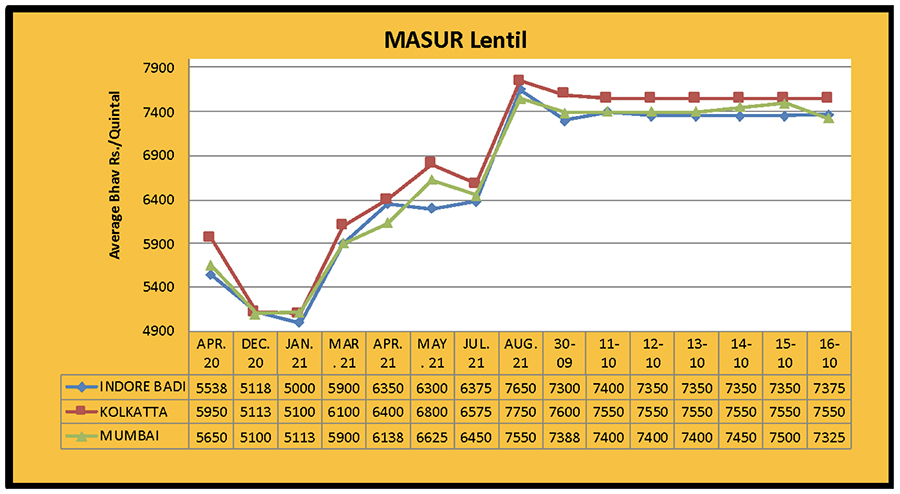
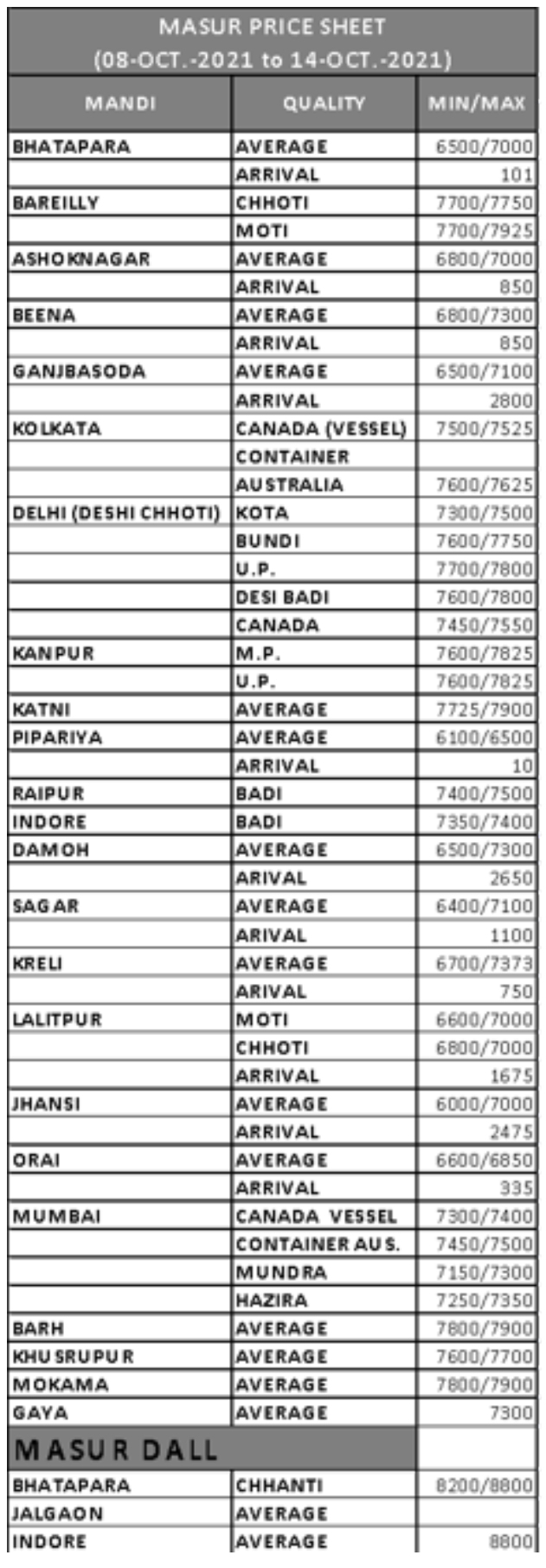
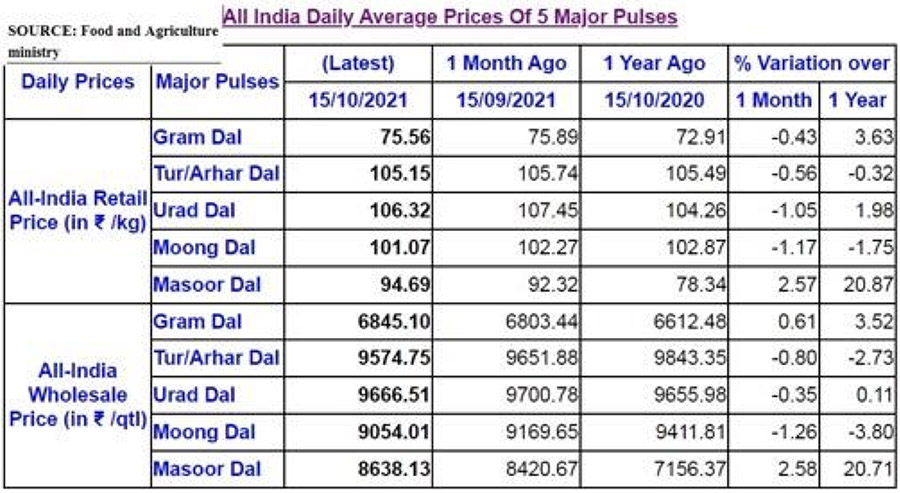
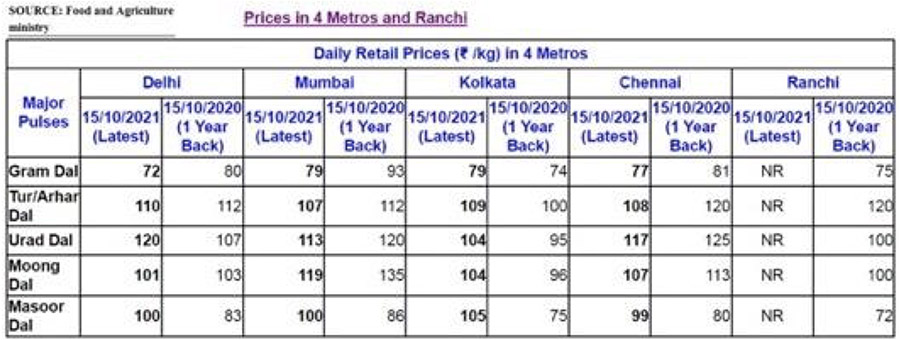
India imported 73,000+ tons of Lentils from Australia in the June-August quarter
After Canada, India imports the most lentils from Australia. According to the Australian Bureau of Statistics (ABS), a total of 73,259 tons of lentils were exported from Australia to India in the period of June to August, comprising 6,855 tons in June, 4989 tons in July and 61,415 tons in August. Lentil imports increased significantly in August after the Indian government announced a sharp cut in customs duty in July. During this period, a total of 2.53 lakh tons of lentils were exported from Australia. Bangladesh was the biggest buyer, of about 83 thousand tons followed by India who imported more than 73,000 tons of Australian lentils.
In the quarter of June-August 2021, more than 33 thousand tons of lentils were exported from Australia to Sri Lanka, about 31 thousand tons to UAE, 14 thousand tons to Egypt, about 11 thousand tons to Nepal and 7200 tons to Pakistan. Apart from this, small quantities of lentils were also shipped from Australia to countries like Fiji, Indonesia, Malaysia, Mauritius, New Zealand, Singapore, South Africa, South Korea, Turkey, Vietnam and Yemen. Although exports to Turkey were expected to increase, no lentils were imported into the country from Australia in June-July and only 750 tons were ordered in August. Australian lentil imports have started increasing in India as of August and they are expected to continue in the upcoming months. The import duty on lentils in India has been reduced from 30 percent to 10 percent. At present, no deadline has been fixed for this but it is broadly believed that this duty cut will be applicable until March 31, 2022 as after that the new domestic crop will be harvested. Due to the high lentil prices in both national and international markets, the sown area of lentils is expected to increase during the Rabi season in India this year. Lentils are mainly produced in four Indian states – Uttar Pradesh, Madhya Pradesh, Bihar and West Bengal - while a limited quantity is cultivated in some other provinces.
Signs of good growth in urad and lentil imports in recent months
Mumbai. The imports of these two important pulses are showing signs of good growth after the central government decided to decontrol the import of urad from the quota system and significantly reduce the customs duty on the import of lentils. According to the available data, in the period of April-July 2020, about 1.62 lakh tons of urad were imported into the country, a number which declined slightly to 1.47 lakh tons in the same period of April-July 2021. After that, however, the pace of imports accelerated. The import of urad during the current year is estimated to have reached 69 thousand tons in July, 55 thousand tons in August and 78 thousand tons in September. There was a huge import of urad in the period of April-September 2021. It is noteworthy that during the entire period (April-March) of the financial year 2020-21, a total of 3.45 lakh tons of urad were imported into the country and 3.12 lakh tons of urad in the financial year 2019-20. It is known that most of the import of urad in India comes from Myanmar, while a small quantity of it is also imported from Argentina and Tanzania.
As far as lentils are concerned, most Indian imports come from Canada and Australia, while limited quantities come from other countries, including the US. In September 2021, more than 75,000 tons of lentils were imported from Canada and more than 16 thousand tons from Australia. 207 tons of lentils were imported from the US. 1.17 lakh tons of lentils were imported in the four months of April-July 2021, which was much less than the total import of 2.60 lakh tons in the same months of the year 2020. According to the data received, more than 37 thousand tons of lentils were imported in the country during July 2021, while in August it jumped to nearly 1.22 lakh tons and in September remained at the high level of 92 thousand tons. In the period of April-September 2021, the total import of lentils is therefore estimated to reach around 3.31 lakh tons. During the financial year 2020-21, the total import of lentils increased sharply to a new high of 11.16 lakh tons, compared to the FY 2019-20, which was slightly more than 8.54 lakh tons.
The customs duty on lentil imports has been cut indefinitely. The arrival of new goods from Australia is expected to pick up from next month. Harvesting in Canada has been completed. This suggests that the import of lentils may increase even more rapidly in the coming months. The reduction in the import duty of lentils is expected to be effective until March 2022.
Possible increase of GST on certain goods and services to simplify the tax structure
The central government is likely to consider raising taxes on certain goods and services with a view to simplifying the tax structure. A panel on the Goods and Services Tax (GST) headed by the Union Finance Minister is expected to hold a meeting in December to consider changing the face of the entire tax structure. At present, a four-stage tax rate is applicable under the GST: namely 5%, 12%, 18% and 28%.
Some items have been kept out of the purview of the GST while essential products like food items have been afforded the lowest rate of tax and the highest rate of tax has been imposed on unhealthy and luxury products. Experts in the matter say that the two minimum tax levels may increase by 1 percentage point to 6% and 13%. The plan is to gradually bring down the tax structure from four tier to three tier, meaning some changes in the existing rate will be necessary. A group of state finance ministers is expected to submit its proposal by the end of next month (November) and an important meeting of the panel is likely to be held in December to discuss the same. The plan to increase the rates of GST will come at a time when the legislative assembly elections will be held early next year in many important provinces, including Uttar Pradesh, Punjab and Uttarakhand. In a country like India, this proposed government decision may prove to be unpopular given that the country is still recovering from the coronavirus pandemic and its economic effects. The government, however, is eager and restless to increase its revenue.
Bihar government may compensate Rs. 650 crores for crop damage
The Bihar Government has given Rs. 650 crores to farmers as compensation for the damage caused to Kharif crops due to excessive rains, severe floods and water logging in the fields.
Elsewhere, an amount of Rs 336.75 crore has been sanctioned. The Bihar government has decided to pay a total of Rs. 550 crores as an input (agriculture) subsidy to farmers to compensate for crop damage, while an amount of Rs 100 crore will be distributed among those farmers who have lost their livelihood due to excessive rainfall and water logging or who could not cultivate any crops in the fields.
An amount of Rs. 193 crores has also been approved in the State Cabinet for the use of the Agriculture Department during the current financial year. Out of this, Rs. 50.61 crore will be used for the implementation of mini kit schemes for pulses and oilseeds under the government scheme and Rs 87.26 crore will be used for the implementation of the Pradhan Mantri Krishi Irrigation Project. There will be a central participation of Rs 36.12 crore and provincial participation of Rs 24.08 crore while the state government will provide an amount of Rs 27.06 crore separately. 56.06 crore will be spent on the National Horticulture Mission. It is worth mentioning that most parts of Bihar received very heavy rainfall during the current year. Since the beginning of the south-west monsoon season, there was excessive rainfall and strong winds, which caused severe floods in many districts and destroyed Kharif crops in vast areas. Flood waters can still be seen in many areas. The monsoon arrived on time but due to the two cyclonic storms in the flood, many parts also received stormy rains, causing extensive damage to paddy, maize, oilseeds and pulses crops.
Cargo operations from Iran, Pakistan and Afghanistan will stop on APSEZ from November 15
Adani Ports and Special Economic Zone (APISE) Limited has issued a trade advisory informing that from November 25, 2021 they will not operate containerized cargoes coming from or going to Iran, Pakistan or Afghanistan.
This means that the movement of containerized cargo for import-export purposes from these countries will be stopped. This trade advisory is applicable for all terminals operated by APSEZ, including third party terminals at any APSEZ port and will remain in effect until further notice. Cargo operators and importers-exporters will have just over a month to settle their earlier contracts. Meanwhile, the movement of ships from other countries will continue. Why and for how long the operation of containerized cargo for import-export business with these three countries will be stopped has not been disclosed. The Corporate Office and Registered Office of the operator of Adani Ports and Special Economic Zone (APSEZ) is located at Khodiyar, Ahmedabad (Gujarat).
Lack of DAP is expected to affect the cultivation of Rabi crops
Due to a lack of adequate stock of chemical fertilizers containing nutrients, the cultivation and progress of Rabi crops in many important agricultural producing states may be negatively affected. Experts believe that there is a huge shortage of Di-ammonium Phosphate (DAP) fertilizers, an important chemical fertilizer that is used extensively in both the Kharif and Rabi seasons.
The country has an annual demand of about 119 lakh tons of DAP of which only 30 per cent is met by domestic production while the remaining part is met by imports from abroad. Wheat, barley, gram, lentils, peas and mustard are cultivated on a large scale during the Rabi season and for this a huge amount of DAP fertilizer is required. Generally, 54 lakh tons of DAP manure is consumed in the Kharif season and 65 lakh tons in the Rabi season. A bumper Rabi crop can only be expected if adequate supply and availability of the fertilizer is ensured. According to the available data, the Central Government has allotted only 67 thousand tons of the DAP quota to Rajasthan for the month of October whereas the demand is 1.50 lakh tons. Similarly, Punjab has been given a quota of 2 lakh tons against a demand of 5.50 lakh tons. Madhya Pradesh requires a huge amount of DAP during the entire Rabi season because wheat, gram, mustard and lentils are all cultivated in large areas. Madhya Pradesh needs 4 lakh tons of DAP in October but the quota allocation is likely to be only 30-40% of this. Maharashtra has not been allotted quota for the current month so it will have to work from the old stock. If the quota is not increased in October then in November all the above states may face an acute shortage of DAP. In Uttar Pradesh, conditions are better. There was a stock of 5.06 lakh tons of DAP available as of October 1, and the requirement for the entire month is only 4.25 lakh tons. It is of note that on June 16, the government had announced an additional subsidy of Rs 14,775 crore on chemical fertilizers over and above the amount fixed in the Union Budget so that farmers can get fertilizers at reasonable rates during the Kharif season. Under this, there was a strong increase of 140 percent in government subsidies on DAP fertilizers.
IMPORTS
Lentil exports from Australia to India remained as follows.
Month- Quantity (in Tons)
June-6,855
July-4,989
Aug-61,415
Total (June-August)-73,259
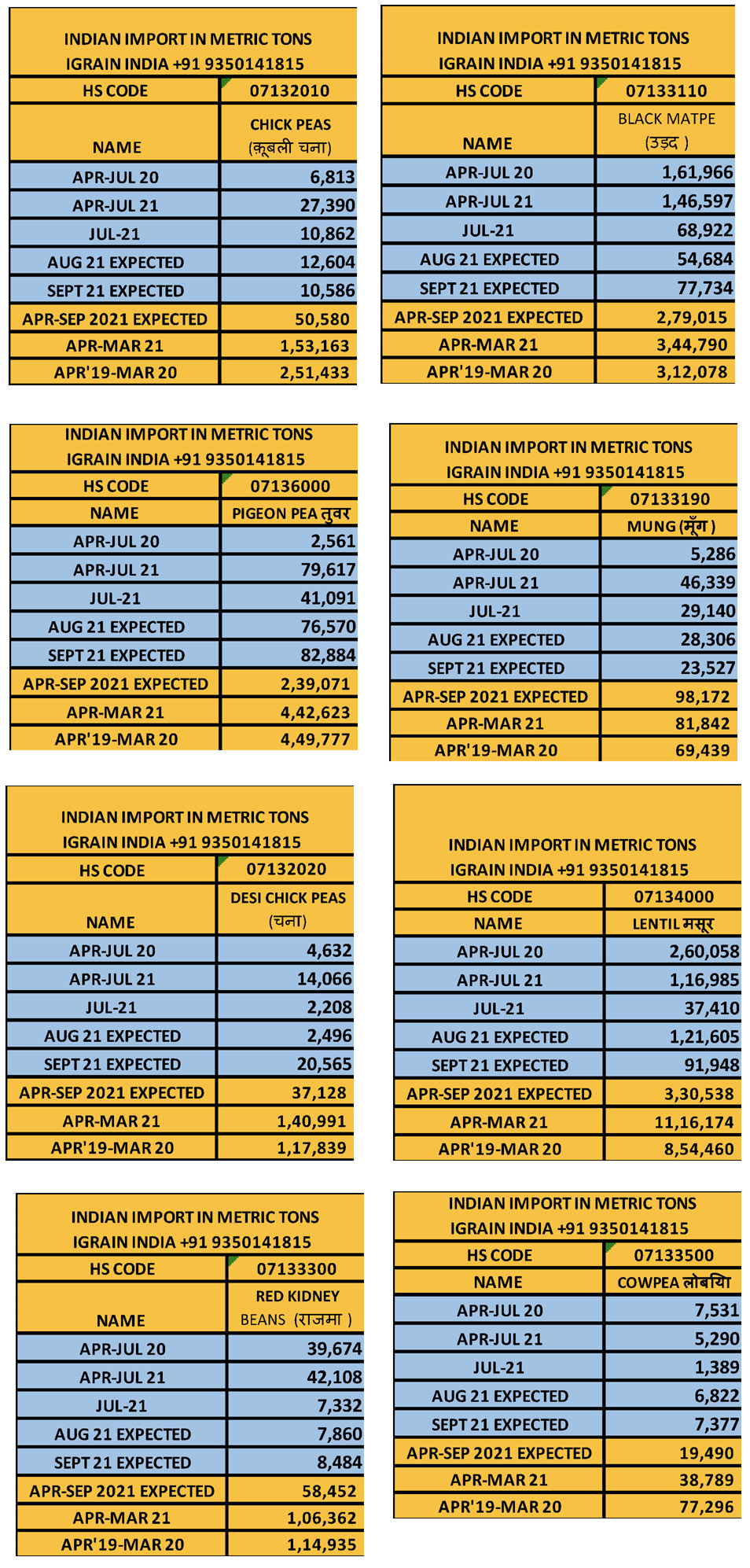
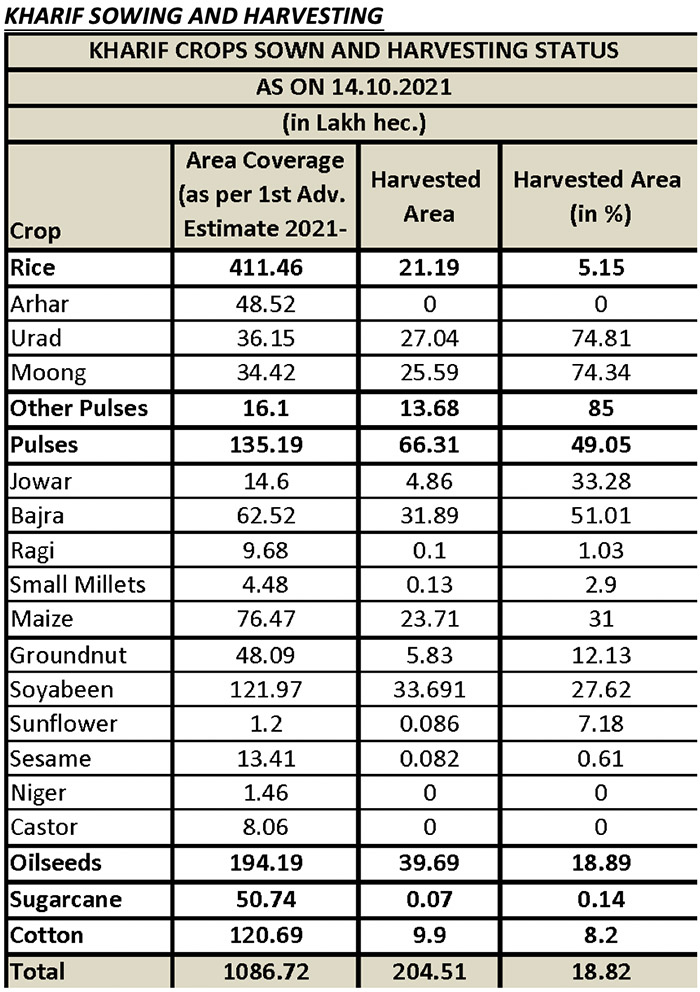
Abbreviations
Tuar/ Arhar: Pigeon Peas PP
Mung: Green Mung
Urad: Black Matpe
Chana: Gram, Desi Chickpea
Matar: Pea
Masur: Lentil
Mandi: Market yard
Bhav: Prices
Dal/Daal: Processed Pulses (Directly for human consumption)
Rs: Indian Rupees (1$=Rs 75.06)
Rahul Chauhan
Director, IGrain India
igrainind@gmail.com
+91 9350141815
Twitter igrain_india

IGrain / Rahul Chauhan / India / Mumbai / Delhi / Madhya Pradesh / Uttar Pradesh / Chickpeas / Desi chick peas / Black matpe / Mung / Red kidney / Cowpea / Lentil / Pigeon pea
Disclaimer: The opinions or views expressed in this publication are those of the authors or quoted persons. They do not purport to reflect the opinions or views of the Global Pulse Confederation or its members.